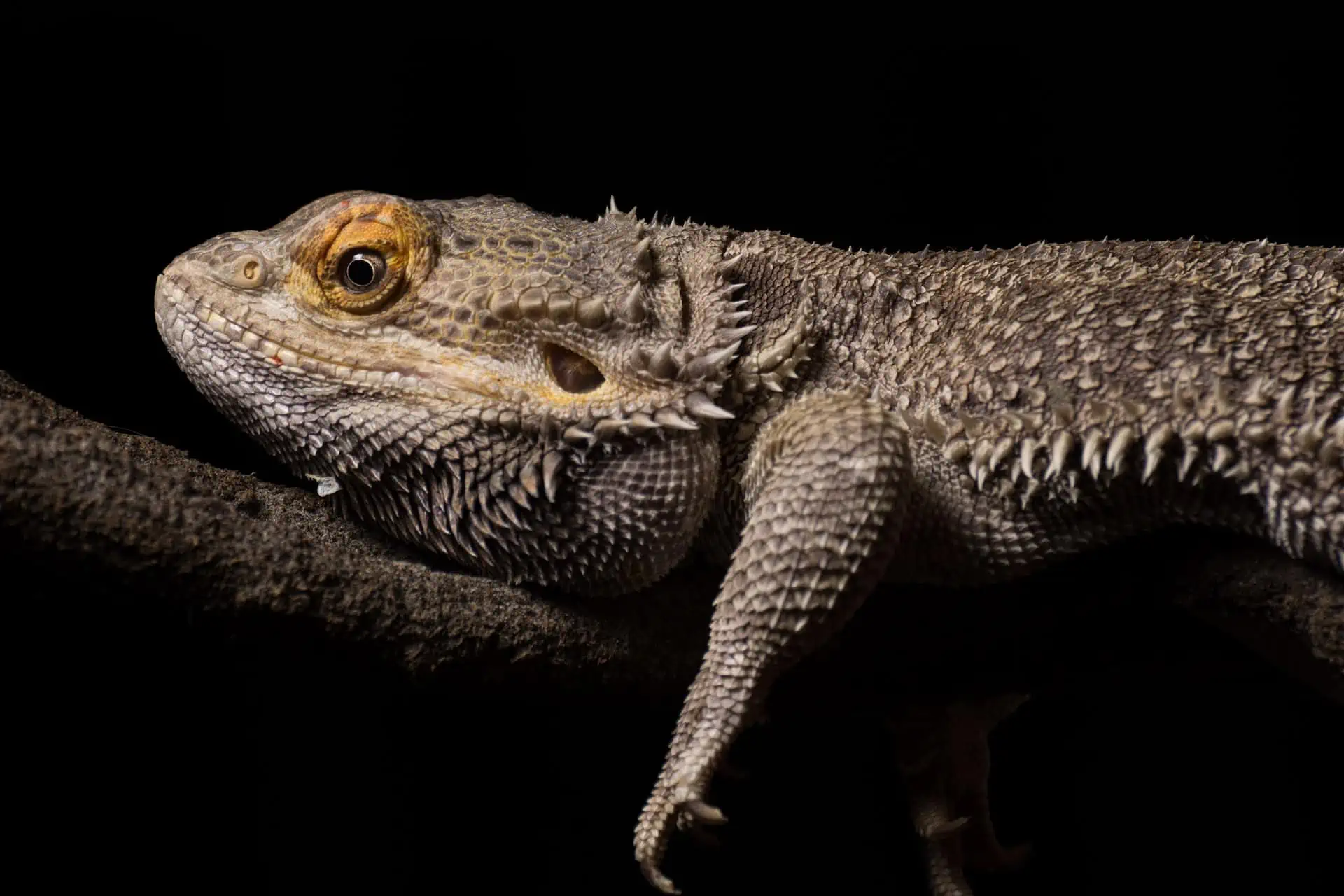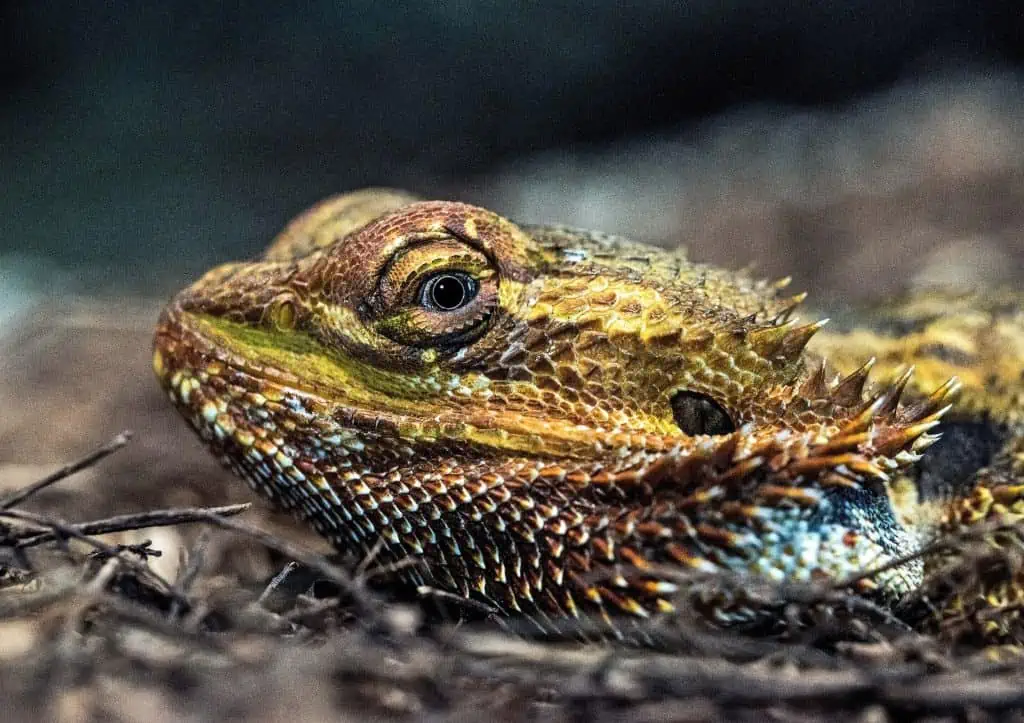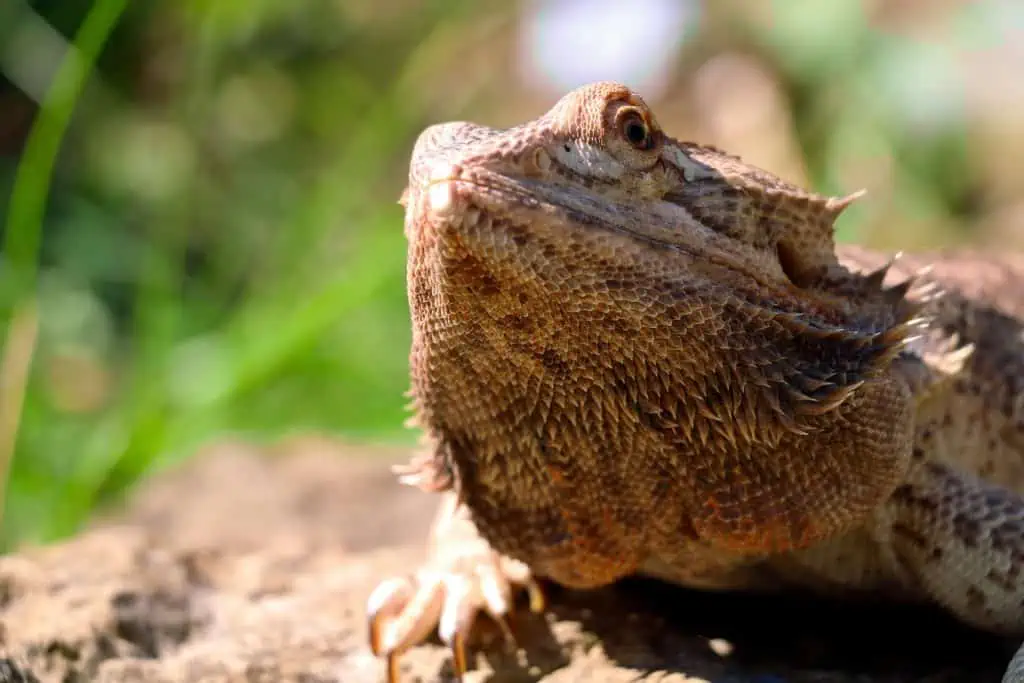Is your bearded dragon’s health declining? Has it stopped eating? Is it lethargic or gasping for breath? Are its eyes sunken, and is it having difficulty moving around? These are a few signs that something is going wrong with your beardie and that it may be dying.
Being a bearded dragon owner, you are the best person to determine if your bearded dragon is not behaving as its usual self. If you have any concerns about your beardie’s health, it is important that you follow up on it so that you can determine if you need to make any husbandry changes or have your pet seen by a veterinarian. This article will provide an overview of what to look out for that may indicate that your bearded dragon is dying.
How Do I Know If My Bearded Dragon Is in Distress?
Signs of your bearded dragon is in distress include:
Loss of Appetite
There are many reasons why a bearded dragon stops eating. Common reasons include:
Improper Husbandry
Not providing the proper temperature and lighting is one of the most common reasons why bearded dragons stop eating. We will discuss this in the next section, What are the Causes of Death for Bearded Dragons?
Disease
Are there other things with your bearded dragon besides not eating? Numerous diseases can cause a bearded dragon to stop eating.
Brumation
Many reptile species go through brumation to adapt to cooler seasons. When in brumation, the bearded dragon’s metabolism slows down significantly. If your bearded dragon is in hiding and appears healthy otherwise, this may explain why it is lethargic. Remember, bearded dragons do not go into brumation until they are nine months or older.
Sometimes, bearded dragons will undergo brumation, which is similar to hibernation. Unlike hibernation, animals who go into brumation do not go into a deep sleep. Instead, their biological functions slow down. They still may occasionally eat and drink.
When in brumation, bearded dragons have been known to go without food for two months. However, there are ways to tell if your bearded dragon is in brumation or ill:
- Bearded dragons who are in brumation will look healthy other than not eating.
- They will find a hiding place where they will go through brumation. They will not stay out in the open.
- Only beardies that are nine months of age or older will brumate.
Lethargy
Bearded dragons are normally alert and curious animals. If your bearded dragon is unresponsive and sluggish, there may be a serious problem. If your bearded dragon is lethargic, consider the following:
- Is the enclosure’s temperature and lighting set up correctly?
- Is it the case that you are not experiencing seasonal changes with cooler temperatures, and your pet is not hiding.
If you can say yes to both statements, your bearded dragon may be ill.
Temperature and Lighting
As I pointed out earlier, check that your pet’s enclosure is at the proper temperature and has UVB lighting. Without the proper lighting and temperature, bearded dragons refuse food, are lethargic, and experience metabolism problems.
Also, I recommend establishing a temperature gradient in your pet’s enclosure where your lizard can choose hot or cooler temperatures. Details for this can be found in the next section, What are the Causes of Death for Bearded Dragons?
Sunken Eyes
Sunken eyes may indicate dehydration. For more information on this, see the next section, What are the Causes of Death for Bearded Dragons?
What are the Causes of Death for Bearded Dragons?
One of the most common causes of death is not providing the proper lighting and temperature. The warmest part of the enclosure should be between 92-110 degrees Fahrenheit, while the coolest part should be between 75-85 degrees Fahrenheit.
Also, bearded dragons need UVB lightening to synthesize Vitamin D and prevent metabolic disease. UVB bulbs need to be replaced every six months as the UVB output declines with time.
Diseases
There are a variety of other causes why your pet’s health may be declining. They include the following:
Infectious Stomatitis
Infectious stomatitis, known as mouth rot, is commonly found in reptiles. The disease shows up as white or yellow-gray patched inside the mouth. There may be swelling in the mouth and drooling.
Bearded dragons with this disease will stop eating and become lethargic. There may also be gastrointestinal, neurological, skeletal, or respiratory issues. If your pet has mouth rot, it needs to be seen by a veterinarian.
Metabolic Bone Disease (MBD)
Metabolic Bone Disease (MBD) is like osteoporosis in humans, and it is caused by inadequate UVB exposure. When reptiles do not have adequate UVB exposure, they cannot form healthy bones. Since there’s a shortage of calcium, the body draws calcium from the bones. Symptoms of MBD include:
- Muscle tremors
- Twitching
- A weak and unhealthy appearance
- The spine or legs have a distorted appearance.
- The lizard cannot close their mouth.
- The dragon has trouble controlling their hind legs.
If your bearded dragon has MBD, it needs to be seen by a veterinarian. MBD can be prevented by providing adequate UVB lighting and providing calcium supplements.
Respiratory Problems
Bearded dragons are susceptible to respiratory infections, such as pneumonia. In most cases, respiratory problems are the result of improper husbandry. The following are symptoms of respiratory illness:
- Discharge from the nostrils or eyes.
- Breathing through an open mouth or gasping for air.
- Lethargy
- Loss of appetite
- Problems with shedding its skin.
If you suspect that your bearded dragon has a respiratory illness, check for the following:
Humidity
The humidity level for bearded dragons should be between 30 and 40 percent. Anything above that is too high.
Temperature
The enclosure should have a temperature gradient where the warmest part of the enclosure is between 92-110 degrees Fahrenheit and the coolest part is between 75-85 degrees Fahrenheit.
Have your dragon seen by a veterinarian and make the needed changes to your pet’s husbandry. You can help prevent dehydration by ensuring that your pet has clean water available to it at all times, giving it baths regularly, and ensuring your pet is getting balanced meals with vitamins and supplements.
Adenovirus
This one is the rarest of all the potential causes of death in bearded dragons. The adenovirus is most commonly found in young, bearded dragons sold at pet stores. The signs that your baby beardie may have this virus are the following:
- Loss of weight
- Rolling over on their back.
- Stretching their neck and staring upward.
Both the rolling on the back and stretching of the neck are due to impairments of the nervous system. I recommend you get your pet to a veterinarian; however, there is no cure for this disease.
Dehydration
Though bearded dragons come from a desert climate, they still need water. Unfortunately, one of the causes of death in captive bearded dragons is dehydration. Signs that your bearded dragon is dehydrated include sunken eyes and the loss of skin elasticity. You can determine this by gently pinching your pet’s skin. If the skin immediately snaps back when you release it, that is a sign that your beardie is dehydrated.
If you suspect dehydration, you need to get your beardie to drink. If there is already a water dish in the enclosure, but they are not drinking from it, use an eye dropper to wet your pet’s snout and see if they lick it up. You can also use Gatorade or Pedialyte to replenish your dragon’s electrolytes.
Impaction
Impaction is a blockage in the digestive tract, and it is caused by ingesting certain food items or certain substrates. Certain feeders, such as mealworms and large crickets, have chitin, which is a tough outer coating.
The accumulation of chitin can cause impaction, so you should feed mealworms sparingly. Not keeping the enclosure at the proper temperature can also be a cause. Signs of impaction may include:
- Lack of bowel movements.
- Difficulty in movement.
- The hind legs appear not to be functioning.
- The inability to eliminate waste.
- Trembling of the legs.
- Dragging of the legs.
If you suspect your lizard has an impaction, you must get it to a veterinarian as soon as possible.
Can You Treat a Sick Bearded Dragon?
Most diseases are curable if they are caught early enough. If your bearded dragon appears to be sick, the best thing to do is to confirm that you are providing it with the correct husbandry, which includes temperature, lighting, and water. If the needed changes do not improve your dragon’s health, then I recommend that you have it seen by a veterinarian.
What Is the Lifespan of a Bearded Dragon?
Bearded dragons live only for three to four years in the wild, mainly due to predators. However, they can live for ten years in captivity. There are claims that some have survived for 13 years.
What Does a Bearded Dragon Look Like When It’s Dead?
This may sound like a ridiculous question, but it justifies a response. This is because some may not know how to tell the difference between a beardie in brumation and one dead. The following are the characteristics of a dead bearded dragon:
- The eyes will be partially closed as opposed to being completely closed.
- The body and jaw will be limp.
- There will be no response when it is touched.
- There is no movement by your pet.
Take Care!
We hope that you enjoyed this article. While many factors result in the death of your bearded dragon, most of them are preventable, given the proper care. Remember, it is our responsibility to give them the best care possible. We would enjoy reading your comments and opinions.





10 Comments
Thank you for this very informative article! I’d wish I never had to search such keywords to read this article.
I badly miss my beardie. Unfortunately, I’ve lost him due to Metabolic Bone Disease (MBD) because we got scammed of purchasing a new UVB light that actually never exposes any UV’s; just emitting light in its habitat (and we detected it way too late). I’m deeply scarred from this experience of mine and pray that no one will ever experience such thing. I would strongly suggest all beardie owners to get UVB testers to prevent such thing from happening.
Godspeed in your journey and creating new memories for your beloved beardies <3
Hi Ameera,
I’m so sorry for your loss. Metabolic Bone Disease is a heartbreaking condition, and it’s understandable that you’re deeply affected by this. It’s incredibly frustrating to be the victim of a scam, especially when it impacts the life of a beloved pet. Thank you for sharing your story to warn others – getting a UVB tester is an excellent suggestion.
Please know that this wasn’t your fault. You did your best to provide for your beardie, and these scammers are the ones to blame. It takes time to heal from these things, so be kind to yourself.
I wish you comfort and healing during this difficult time.
My bearded dragon Tupac is approximately 20 years old and he’s hanging on by a thread. He is emaciated and not moving at all but he occasionally opens his mouth slightly when I hold him. It’s going to be anytime now. I just hope he’s not suffering as life leaves him.
Hi Tony,
I’m so sorry to hear that Tupac is in such a fragile state. It sounds like you’ve provided Tupac with excellent care. Twenty years is an extraordinary lifespan for a bearded dragon.
Try to focus on ensuring Tupac’s comfort. Offering gentle warmth from a heating pad or warm water bottle (wrapped in a towel) might give some relief. Make sure he has easy access to water, even if he doesn’t show active interest in drinking. You can even try offering small drops of water on his nose to see if he’ll take them.
Given his age and condition, I’d strongly advise considering seeking a veterinarian’s advice, even if it’s just a consultation. They might be able to guide you on providing comfort measures, or potentially explore options such as humane euthanasia if Tupac appears to be suffering.
Please know that you’re not alone. Losing a pet is an incredibly difficult experience. Take the time to take care of yourself too.
I have bee taking the time to read this article and subsequent thread at length, and I have to say that you are so empathic. Compassionate care for both the pet and their humans…how wonderful. Thank you for sharing so much of yourself.
Very best,
The Rose-Lynch family (including our beloved rescue Beardie, Reuben)
We have had a beaded dragon that showed now sign of illness 7 days ago. Eating moving climbing drinking all good. Then three days ago its beard turned black and then it stopped moving and eating even when food was brought to it.
Then the following day she died.
We can figure out what went on she was around 7 years old and always healthy prior.
We are interested in what happened so fast
Hi Jason,
I’m so sorry to hear about the sudden loss of your bearded dragon. It’s understandable that you’d be confused and seeking answers. Here are some possible explanations for what might have happened:
Adenovirus/Atadenovirus: This viral infection can cause sudden lethargy, loss of appetite, and unfortunately, death. It’s especially common in young bearded dragons but can affect them at any age.
Metabolic Bone Disease (MBD): Even with a good diet, sometimes underlying calcium or vitamin D3 deficiencies can take a sudden turn for the worse, leading to weakness, paralysis, and organ issues.
Impaction: If your bearded dragon accidentally ingested some substrate, a large food item, or has internal parasites, a blockage can lead to a rapid decline.
Respiratory Infection: Incorrect temperatures or humidity in the enclosure could have led to an infection that progressed quickly.
Internal Parasites: A heavy parasite load can weaken the immune system and cause a sudden decline in health.
Organ Failure: Possible issues with the kidneys, liver, or heart, potentially due to age, may have led to the sudden change.
Toxicity: It’s possible your bearded dragon was exposed to a toxin in the environment.
It’s difficult to say exactly what the cause was without a veterinarian’s examination. If possible, a necropsy (animal autopsy) could provide more definitive answers.
Losing a pet is never easy. Please remember it’s unlikely to be your fault; sometimes these things are beyond our control.
Let me know if you have any other questions.
I liked your article ! Very informative! I’m caring for a Beardi who is at least 15 years old. Inherited from my grandsons when they went off to school. He’s really slowing down and seems to be at the end of life but continues at a very low energy level. Eats occasionally but only when hand fed. Doesn’t seek out food. Spends occasional time bathing at his water dish. I give him frequent baths. He has good lighting and temperature. I still take him out in the sun occasionally, (when it’s warm enough.) He’s very thin and reminds me of a relative who passed away but became very thin and barely ate toward the end of life. This seems like The Natural end of a long but I can’t be sure. Occasionally he Springs back to life with youthful vigor. I do want to keep him comfortable. Any suggestions would be appreciated.
Hi Mark,
Taking care of an old bearded dragon is a bit like looking after a grandparent. It’s great that you’re providing him with good care.
For his diet, focus on low-calorie foods, as older dragons are less active. Assisted feeding can be beneficial if they’re too weak to eat on their own. Chopping food into small pieces is a good practice to prevent choking. Since their bodies aren’t growing, they don’t need much supplementation; just some calcium and vitamins periodically. Offer staple greens, veggies, and occasional fruit slices, and avoid high-fat bugs like mealworms or super worms.
Hydration is also vital. Older dragons may experience decreased kidney function, so ensure regular water intake either by spraying or dropping water on their nose or mouth. Hydrating veggies and fruits can also help.
Creating a stress-free environment is important. Eliminate stress factors like loud noises, overly bright light, or anything that may cause discomfort. Ensure the habitat is comfortable and easy to navigate, as older dragons can have difficulty moving and climbing.
Keep the basking area warm, between 92-110°F, and the cool side between 75-85°F to support their immune system. Lastly, consider humane options for end-of-life care if they’re suffering.
Your commitment to their comfort is admirable.
This is what we seem t be experiencing with our beloved Beardie, Reuben. He’s only between 6-7 but was not well cared for before we saved him. He definitely has MBD. We seemed to bring him “back to life” and he even seemed happy-like he was smiling this past winter. He began to present with a great appetite after we gave him the quality of care and love he deserves. He loves it when I sing to him. He just seems to be tired and done with everything now. He hasn’t been interested in any food at all this past week. I just let him lie on my body as much as possible. He likes the vibration of me heart beat and to hide under my scarf.